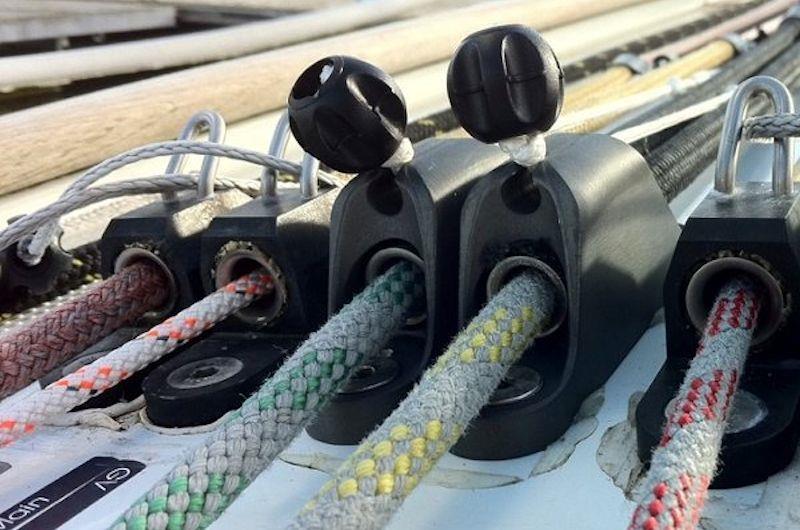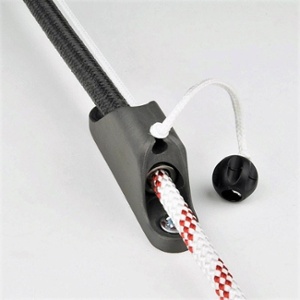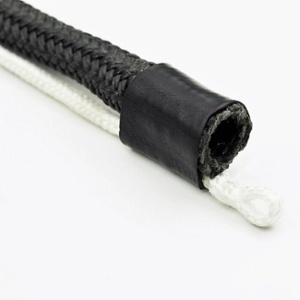
Cousin Trestec Constrictor - A Textile Rope Clutch!?
by Kerri Robson 18 Feb 2019 09:00 UTC

Cousin Trestec Constrictor - A Textile Rope Clutch © Cousin Trestec
At some point in our lives, we have all experienced the vice-like grip of the 'Chinese finger trap'; when pulled, the cylindrical, woven braid is designed to contract and constrain the finger. It is this mechanism that forms the simple premise behind French brand Cousin Trestec's rope 'constrictor'.
Cousin Trestec a key player in the manufacture of innovative marine ropes and braided textiles - first designed the constrictor a number of years ago. The product revolutionised the French offshore racing scene, and has gained in popularity ever since, with more and more racing and cruising sailors choosing the lightweight, high load constrictor over more traditional rope clutch designs.
The patented constrictor design which has previously won a DAME award - is simple yet effective. Working as a fibre-on-fibre rope clutch, the system utilises a hollow, braided, textile sock that - in one direction - enables rope to run freely, but - in the opposite direction - immediately locks the rope into place.
In order to lock the line into place, the constrictor uses friction: under load, the sock instantly clings to the rope, stopping it in its tracks. Also, unlike traditional cam-based clutches, the higher the load, the greater the hold!

Releasing the rope is also uncomplicated: simply pull on the control line to retract the sock and it will release hold on the rope. The control line can also remain pinned back, allowing the rope to run freely both ways. There is also potential for the control line to be extended, allowing the rope to be released remotely if desired. This opens up some interesting opportunities for using them as halyard locks on small boats!
But what are the advantages of using a textile constrictor over a metal rope clutch?
A significant benefit is that fibre-on-fibre interaction is not as harsh as metal on fibre. Whilst some traditional rope clutches crush the rope between metal jaws, the soft braid on soft braid ensures there is no abrasion on the rope - and as a result the Cousin Constrictor is kinder to your running rigging (and therefore your wallet!). The braided sock also ensures a balanced distribution of the grip. The result? Less wear and tear, plus lower maintenance costs.
Another advantage is weight: the Cousin Constrictor is three times lighter than a conventional metal clutch, increasing performance and perfectly aligning with Upffront.com's motto of faster, lighter, safer sailing.

In addition, the Cousin Trestec Constrictor is twice as strong as a traditional rope clutch; the line can be taken off the winch without worries of slippage, with the break strength of the textile clutch equalling the break strength of the rope it is retaining (the only limit being the strength of the surface the clutch is mounted on!). The line can also be released under any load without the assistance of a winch, which can be deemed as safer in critical situations.
Benefitting from easy installation and maintenance, the Cousin Constrictor is also mountable anywhere although, due to its length, it does require more space on deck than some traditional rope clutches. However, the lack of moving metal parts ensures corrosion is low and, if damage occurs, the sock can be replaced as an individual part.
Ready to make the move towards a textile clutch? The unique constrictor comprises an aluminium housing (which acts as the mountable anchor base), a textile sock made of aramid fibres, a 'nut and olive' coupling system to fix the sock in the housing, a shock cord and a Dyneema® control line.
Explore the Cousin Trestec Constrictor range at upffront.com, or contact upffront.com using the running rigging enquiry form.